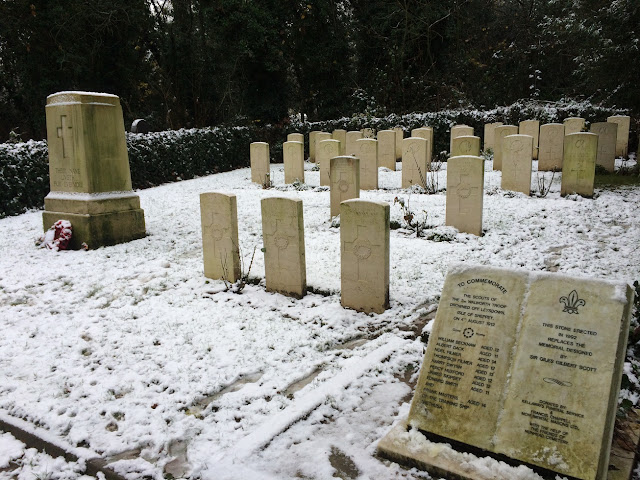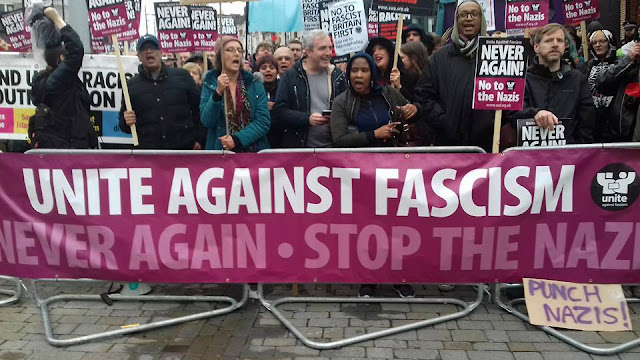Some interesting material in the University of Warwick's digital archive on
British Political Theatre 1930s to 1950s, including some newsletters from the 1930s from the Workers Theatre Movement, associated with the Communist Party.
As mentioned here before, South London was a focus for this kind of theatre, with performances of agitational sketches and songs given in the streets, at meetings and at shows.
According to '
Class against class: the Communist Party in Britain Between the Wars', (Matthew
Worley, 2002): 'Communist theatre groups had begun to appear
throughouth the country by the turn of the decade [the 1930s]. In London alone, ten such troupes, including the Red Star Troupe of West London, Red Radio of Hackney, the Red Magnets of
Woolwich, the Red Front of
Streatham, the Red Players of
Lewisham, the Red Blouses of Greenwich and the Yiddish-speaking
Proltet, existed by 1931’.
The
Lewisham Red Players performed in
Lewisham High Street and elsewhere, with their group chorus going:
“There is a word you
mustn’t say –
revo-
lution
All the same it’s on the way – the workers’ revolution
Every day the world turns round -
revo-
lution
A few more turns, it will resound -
revo-
lution
It’s coming here, it’s coming there -
revo-
lution
The ground is tumbling everywhere – the workers’ revolution”.
(source: Raphael Samuel in
Performance and Politics in Popular Drama: Aspects of Popular Entertainment in Theatre, Film and Television, 1800–1976, edited by David Brady, 1980)
The Red Players included in their ranks Charlie Mann, son of the veteran Communist and trade unionist
Tom Mann, the latter who lived in
Brockley in the 1920s (in 1927 his address was 1 Adelaide Road).
Charles B Mann (1905-1989) was editor of the Workers' Theatre Movement journal 'Red Stage', with his address given in the November 1931 issue as 61 Sydenham Park SE26.

Red Stage (November 1931) mentions new groups being set up in Croydon and Woolwich and 'the revival of the Deptford Group', and open-air 'Red Radio' shows in Bermondsey and Greenwich. The January 1932 issue includes a report from the Streatham-based 'Red Front Troupe, South London' stating that it had 'nine effective members, three of whom are women' and that in November 1932 they had given five shows and set up an unemployed troupe linked to the National Unemployed Workers Movement. The South London 'Red Players' reported that they had helped set up new groups in Croydon, Woolwich and Camberwell and were planning 'full WTM shows in Croydon, Lewisham and Woolwich'. The folowing month's issue (February 1932) includes reports from Red Blouses in Greenwich, Red Magnets (Woolwich) - planning a big show at Plumstead Baths - and Red Players, planning shows in Croydon, Lewisham and elsewhere.
The movement, which argued that 'Our theatre awakens the masses', presented theatre that condemned capitalism and promoted the workers movement, but there were disagreements about the best way of doing this. Within the pages of these publications we see some healthy debate about the role of the theatre and other issues. For instance the Jewish communist theatre troupe Proltet mounted a strong defence of doing performances in Yiddish, against criticism from some in the Party (WTM Monthly Bulletin, February 1933). There was a debate about jazz, with a letter arguing that 'it seems a great pity that, when so many fine revolutionary and other great melodies are available, it is found necessary to descend to the level of the American jazz exploiters' (Red Stage, January 1932) and a response that to reach the masses it was necessary to use tunes from popular culture - 'jazz brings us nearer to the workers' (February 1932).
A critical review in the Communist Party's Daily Worker attacked the tendency to 'individual self boosting' in the Workers Theatre Movement, provoking a firm response from the Red Players of South London: 'If Comrade Bennett's ideal state is one in which the individual is prohibited from personal expression, then that is not the state we are fighting for' (
Red Stage, January 1932). There is a tragic historical irony that in Stalin's USSR - celebrated by the Workers Theatre Movement - such views could lead to the Gulag in this period.
 |
| Red Stage, January 1932 giving contact addresses for the Red Front troupe (16 Buckleigh Road, SW16 and for the Red Players (S. Banks, 22 Campshill Road, SE13) |






















































